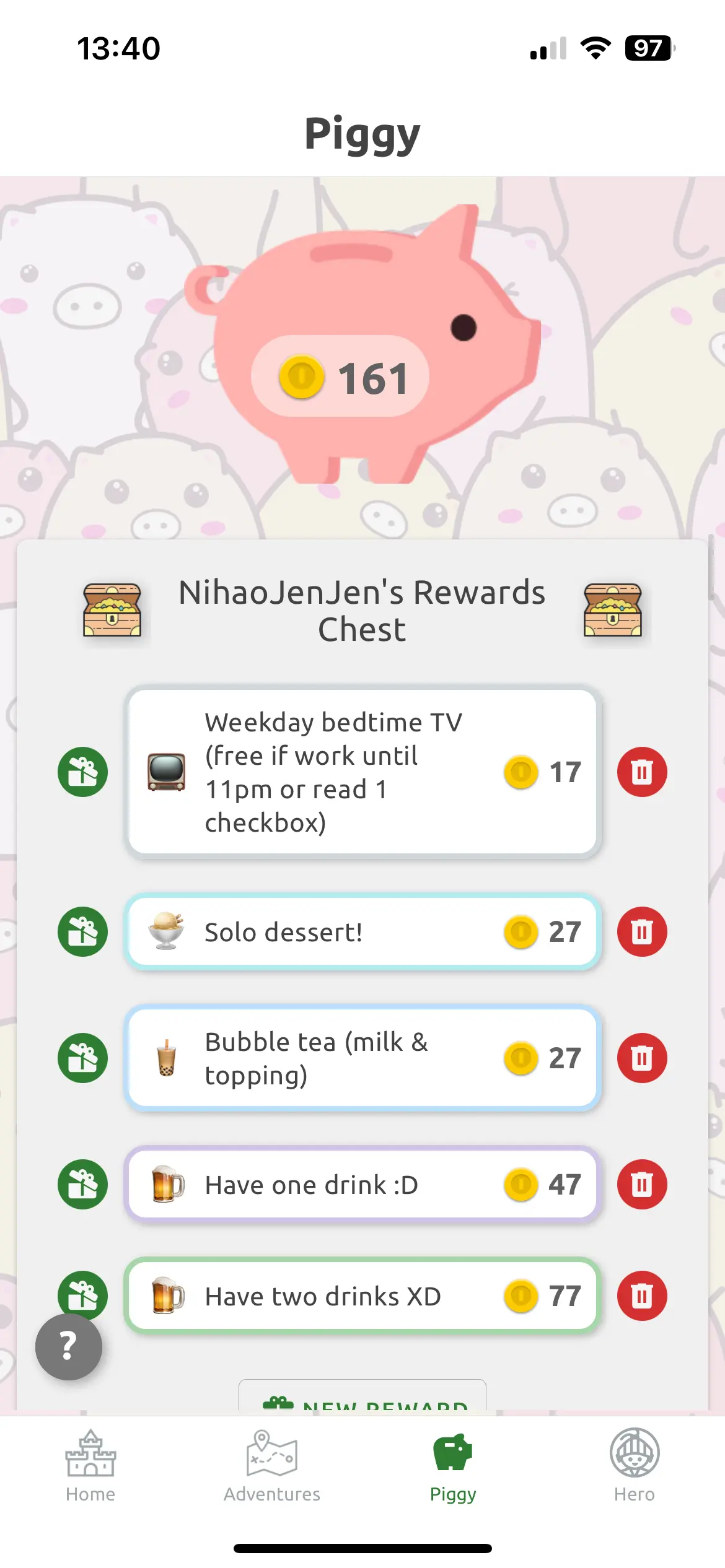
I have been using HeroMode's Piggy Rewards System for a few years now, and I've started to notice a pattern. Well, it's actually quite an obvious pattern once you notice it. Every year, I rack up a lot of Piggy Debt around the holidays. And every year, after getting back to work, perhaps driven by guilt, perhaps driven by professionalism (why not both?), I slowly add back coins to my Piggy Bank. This year, it took me all the way until October to finally pay off my Piggy Debt! In honor of this 100% fictional (but motivating) financial milestone, I dug deeper into my productivity data.
The Piggy Rewards System
Nowadays, whenever you go to a resutrant, or even a bobba shop, you'd be asked to sign up or create an account to accumulate points and earn rewards. We all know this is a common strategy to keep customers coming back.
It's a common strategy because it works. But eating out more or drinking more bobba might not be in our best interest. So the Piggy Rewards System in HeroMode is a way to apply the same mechanism for our own productivity.
The Piggy Rewards System is completely customizable. You define the rewards that motivate you, and you earn coins by completing quests.

Above: My Piggy rewards customized to motivate myself.
Is Piggy Debt Motivating?
When we were designing the Piggy Rewards System a few years ago, we gathered feedbacks from the early users. One big question we had was, if we should allow users to redeem rewards when they have not earned enough coins.
I don't think we have ever come to a very scientific, very research-backed conclusion on this topic. But users did not like to be prevented from redeeming rewards. To them, this restriction feels like a product friction. Sometimes you want to enjoy the fruit of your labor first, and then put in the labor.
As a result, we had a very video game-like design: a simple upper bound and lower bound on how much piggy coins you can have. Up to 999 coins, and no more than -999 of debt.

Above: Piggy Rewards System allows users to accrue some Piggy Debt.
Holidays are for Piggy Debt!
Even though I was originally skeptical about allowing users to accrue Piggy Debt, once it was released, I do find myself occasionally over-indulging on Piggy rewards and go into the negative territory. Most of the time, the debt is small and paid off quickly. But during holidays, with all the desserts and good vibes, I see myself digging deeper and deeper into Piggy Debt.
This year, in particular, it took me a long time to claw my way back into the positive zone. It all started around November of last year. It was Thanksgiving time, the traditional holiday for feasting with friends and family. With all the delicious desserts and drinks, I redeemed Piggy rewards like I was writing checks with someone else's bank account.
Thanksgiving quickly gave way to Christmas and then New Year's, more occassions to let loose and be merry. When January 1st passed, the reason to celebrate was not over yet. Chinese New Year rolled around, and how could I miss the opportunity to have a good time with family?
The result of this three-month span? I was deep in Piggy Debt - at some point, my account was lower than -340 coins, the most extreme I have ever seen!

Above: My one year journey to get out of Piggy Debt.
Back to Work and Paying Off Piggy Debt
After all the parties and feasts were over, it was time to get back to work. Slowly, and inch by inch, I clawed my way back out of Piggy Debt. But it took me the better part of the year. It wasn't until near the end of October that I finally crossed the zero-debt line.
I was curious if I also had the similar pattern last year. Previously, I had noticed that I had some weekly pattern in productivity, where I earn coins during the weekdays and spend them on the weekends. This pattern is very much expected. And now, I'm wondering if there are also seasonal and annual patterns. And indeed, there are! The holiday splurge is not just a one-time event. And the post-holiday productivity redemption is also a recurring pattern. Interestingly, in the last couple of years, the common trend seems to be:
- Holidays: Spend is higher than coins earned.
- January: Back to work with increased productivity and lower spending.
- Summer: Periods of lower productivity and higher spending.
- Autumn: Back to work with increased productivity and lower spending.
- Holidays: Let's do it all over again!

Above: There are some clear patterns in my seasonal productivity.
What did I Learn from this Analysis?
Our productivity rises and falls naturally. There are patterns on different time scales. On the daily level, some people are early birds, and some are night owls. On the weekly level, we all have our days of the week when we feel "in the zone". And, on the yearly level, there are also periods of heightened productivity, and seasons where we need to relax and recharge.
Similar to how an organization pays a lot of attention to their employees' performance, knowing our own patterns of productivity can help us optimize our output. We are working on making it easier to explore your own productivity data within HeroMode, so that you can run analysis like this easily. Stay tuned!
